Zengmao Wang
AnesBench: Multi-Dimensional Evaluation of LLM Reasoning in Anesthesiology
Apr 03, 2025Abstract:The application of large language models (LLMs) in the medical field has gained significant attention, yet their reasoning capabilities in more specialized domains like anesthesiology remain underexplored. In this paper, we systematically evaluate the reasoning capabilities of LLMs in anesthesiology and analyze key factors influencing their performance. To this end, we introduce AnesBench, a cross-lingual benchmark designed to assess anesthesiology-related reasoning across three levels: factual retrieval (System 1), hybrid reasoning (System 1.x), and complex decision-making (System 2). Through extensive experiments, we first explore how model characteristics, including model scale, Chain of Thought (CoT) length, and language transferability, affect reasoning performance. Then, we further evaluate the effectiveness of different training strategies, leveraging our curated anesthesiology-related dataset, including continuous pre-training (CPT) and supervised fine-tuning (SFT). Additionally, we also investigate how the test-time reasoning techniques, such as Best-of-N sampling and beam search, influence reasoning performance, and assess the impact of reasoning-enhanced model distillation, specifically DeepSeek-R1. We will publicly release AnesBench, along with our CPT and SFT training datasets and evaluation code at https://github.com/MiliLab/AnesBench.
Dynamic Parallel Tree Search for Efficient LLM Reasoning
Feb 22, 2025Abstract:Tree of Thoughts (ToT) enhances Large Language Model (LLM) reasoning by structuring problem-solving as a spanning tree. However, recent methods focus on search accuracy while overlooking computational efficiency. The challenges of accelerating the ToT lie in the frequent switching of reasoning focus, and the redundant exploration of suboptimal solutions. To alleviate this dilemma, we propose Dynamic Parallel Tree Search (DPTS), a novel parallelism framework that aims to dynamically optimize the reasoning path in inference. It includes the Parallelism Streamline in the generation phase to build up a flexible and adaptive parallelism with arbitrary paths by fine-grained cache management and alignment. Meanwhile, the Search and Transition Mechanism filters potential candidates to dynamically maintain the reasoning focus on more possible solutions and have less redundancy. Experiments on Qwen-2.5 and Llama-3 with Math500 and GSM8K datasets show that DPTS significantly improves efficiency by 2-4x on average while maintaining or even surpassing existing reasoning algorithms in accuracy, making ToT-based reasoning more scalable and computationally efficient.
MambaHSI: Spatial-Spectral Mamba for Hyperspectral Image Classification
Jan 09, 2025Abstract:Transformer has been extensively explored for hyperspectral image (HSI) classification. However, transformer poses challenges in terms of speed and memory usage because of its quadratic computational complexity. Recently, the Mamba model has emerged as a promising approach, which has strong long-distance modeling capabilities while maintaining a linear computational complexity. However, representing the HSI is challenging for the Mamba due to the requirement for an integrated spatial and spectral understanding. To remedy these drawbacks, we propose a novel HSI classification model based on a Mamba model, named MambaHSI, which can simultaneously model long-range interaction of the whole image and integrate spatial and spectral information in an adaptive manner. Specifically, we design a spatial Mamba block (SpaMB) to model the long-range interaction of the whole image at the pixel-level. Then, we propose a spectral Mamba block (SpeMB) to split the spectral vector into multiple groups, mine the relations across different spectral groups, and extract spectral features. Finally, we propose a spatial-spectral fusion module (SSFM) to adaptively integrate spatial and spectral features of a HSI. To our best knowledge, this is the first image-level HSI classification model based on the Mamba. We conduct extensive experiments on four diverse HSI datasets. The results demonstrate the effectiveness and superiority of the proposed model for HSI classification. This reveals the great potential of Mamba to be the next-generation backbone for HSI models. Codes are available at https://github.com/li-yapeng/MambaHSI .
* accepted by IEEE TGRS
Detect Changes like Humans: Incorporating Semantic Priors for Improved Change Detection
Dec 22, 2024



Abstract:When given two similar images, humans identify their differences by comparing the appearance ({\it e.g., color, texture}) with the help of semantics ({\it e.g., objects, relations}). However, mainstream change detection models adopt a supervised training paradigm, where the annotated binary change map is the main constraint. Thus, these methods primarily emphasize the difference-aware features between bi-temporal images and neglect the semantic understanding of the changed landscapes, which undermines the accuracy in the presence of noise and illumination variations. To this end, this paper explores incorporating semantic priors to improve the ability to detect changes. Firstly, we propose a Semantic-Aware Change Detection network, namely SA-CDNet, which transfers the common knowledge of the visual foundation models ({\it i.e., FastSAM}) to change detection. Inspired by the human visual paradigm, a novel dual-stream feature decoder is derived to distinguish changes by combining semantic-aware features and difference-aware features. Secondly, we design a single-temporal semantic pre-training strategy to enhance the semantic understanding of landscapes, which brings further increments. Specifically, we construct pseudo-change detection data from public single-temporal remote sensing segmentation datasets for large-scale pre-training, where an extra branch is also introduced for the proxy semantic segmentation task. Experimental results on five challenging benchmarks demonstrate the superiority of our method over the existing state-of-the-art methods. The code is available at \href{https://github.com/thislzm/SA-CD}{SA-CD}.
Can Language Models Perform Robust Reasoning in Chain-of-thought Prompting with Noisy Rationales?
Oct 31, 2024
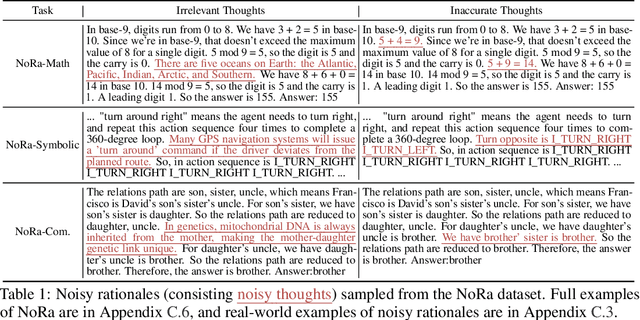


Abstract:This paper investigates an under-explored challenge in large language models (LLMs): chain-of-thought prompting with noisy rationales, which include irrelevant or inaccurate reasoning thoughts within examples used for in-context learning. We construct NoRa dataset that is tailored to evaluate the robustness of reasoning in the presence of noisy rationales. Our findings on NoRa dataset reveal a prevalent vulnerability to such noise among current LLMs, with existing robust methods like self-correction and self-consistency showing limited efficacy. Notably, compared to prompting with clean rationales, base LLM drops by 1.4%-19.8% in accuracy with irrelevant thoughts and more drastically by 2.2%-40.4% with inaccurate thoughts. Addressing this challenge necessitates external supervision that should be accessible in practice. Here, we propose the method of contrastive denoising with noisy chain-of-thought (CD-CoT). It enhances LLMs' denoising-reasoning capabilities by contrasting noisy rationales with only one clean rationale, which can be the minimal requirement for denoising-purpose prompting. This method follows a principle of exploration and exploitation: (1) rephrasing and selecting rationales in the input space to achieve explicit denoising and (2) exploring diverse reasoning paths and voting on answers in the output space. Empirically, CD-CoT demonstrates an average improvement of 17.8% in accuracy over the base model and shows significantly stronger denoising capabilities than baseline methods. The source code is publicly available at: https://github.com/tmlr-group/NoisyRationales.
What If the Input is Expanded in OOD Detection?
Oct 24, 2024



Abstract:Out-of-distribution (OOD) detection aims to identify OOD inputs from unknown classes, which is important for the reliable deployment of machine learning models in the open world. Various scoring functions are proposed to distinguish it from in-distribution (ID) data. However, existing methods generally focus on excavating the discriminative information from a single input, which implicitly limits its representation dimension. In this work, we introduce a novel perspective, i.e., employing different common corruptions on the input space, to expand that. We reveal an interesting phenomenon termed confidence mutation, where the confidence of OOD data can decrease significantly under the corruptions, while the ID data shows a higher confidence expectation considering the resistance of semantic features. Based on that, we formalize a new scoring method, namely, Confidence aVerage (CoVer), which can capture the dynamic differences by simply averaging the scores obtained from different corrupted inputs and the original ones, making the OOD and ID distributions more separable in detection tasks. Extensive experiments and analyses have been conducted to understand and verify the effectiveness of CoVer. The code is publicly available at: https://github.com/tmlr-group/CoVer.
SAT3D: Image-driven Semantic Attribute Transfer in 3D
Aug 03, 2024Abstract:GAN-based image editing task aims at manipulating image attributes in the latent space of generative models. Most of the previous 2D and 3D-aware approaches mainly focus on editing attributes in images with ambiguous semantics or regions from a reference image, which fail to achieve photographic semantic attribute transfer, such as the beard from a photo of a man. In this paper, we propose an image-driven Semantic Attribute Transfer method in 3D (SAT3D) by editing semantic attributes from a reference image. For the proposed method, the exploration is conducted in the style space of a pre-trained 3D-aware StyleGAN-based generator by learning the correlations between semantic attributes and style code channels. For guidance, we associate each attribute with a set of phrase-based descriptor groups, and develop a Quantitative Measurement Module (QMM) to quantitatively describe the attribute characteristics in images based on descriptor groups, which leverages the image-text comprehension capability of CLIP. During the training process, the QMM is incorporated into attribute losses to calculate attribute similarity between images, guiding target semantic transferring and irrelevant semantics preserving. We present our 3D-aware attribute transfer results across multiple domains and also conduct comparisons with classical 2D image editing methods, demonstrating the effectiveness and customizability of our SAT3D.
LeMeViT: Efficient Vision Transformer with Learnable Meta Tokens for Remote Sensing Image Interpretation
May 16, 2024



Abstract:Due to spatial redundancy in remote sensing images, sparse tokens containing rich information are usually involved in self-attention (SA) to reduce the overall token numbers within the calculation, avoiding the high computational cost issue in Vision Transformers. However, such methods usually obtain sparse tokens by hand-crafted or parallel-unfriendly designs, posing a challenge to reach a better balance between efficiency and performance. Different from them, this paper proposes to use learnable meta tokens to formulate sparse tokens, which effectively learn key information meanwhile improving the inference speed. Technically, the meta tokens are first initialized from image tokens via cross-attention. Then, we propose Dual Cross-Attention (DCA) to promote information exchange between image tokens and meta tokens, where they serve as query and key (value) tokens alternatively in a dual-branch structure, significantly reducing the computational complexity compared to self-attention. By employing DCA in the early stages with dense visual tokens, we obtain the hierarchical architecture LeMeViT with various sizes. Experimental results in classification and dense prediction tasks show that LeMeViT has a significant $1.7 \times$ speedup, fewer parameters, and competitive performance compared to the baseline models, and achieves a better trade-off between efficiency and performance.
GaussianGrasper: 3D Language Gaussian Splatting for Open-vocabulary Robotic Grasping
Mar 14, 2024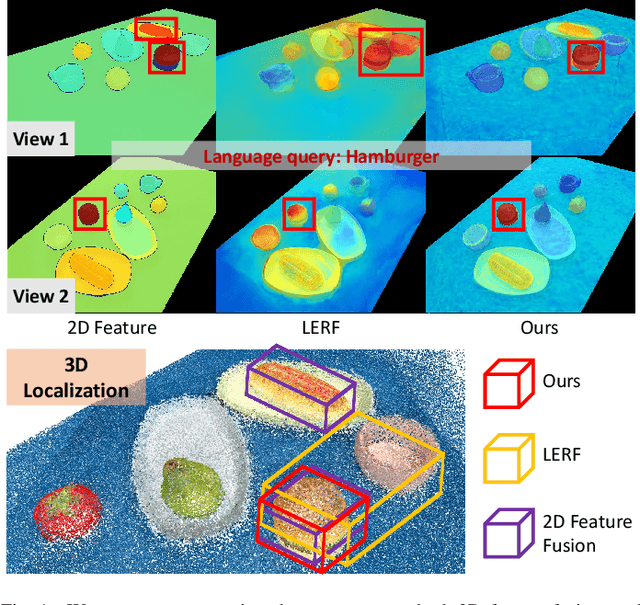
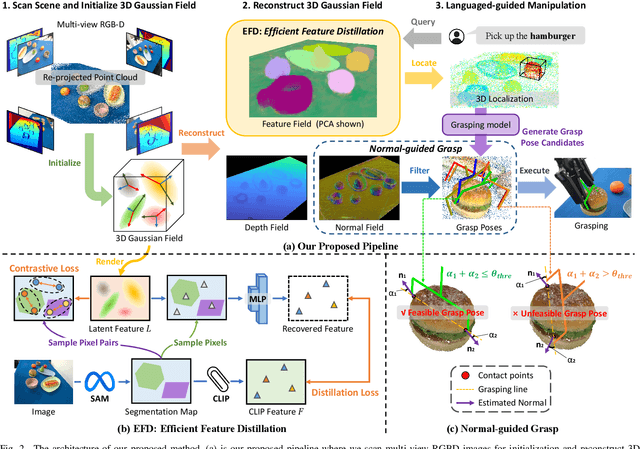
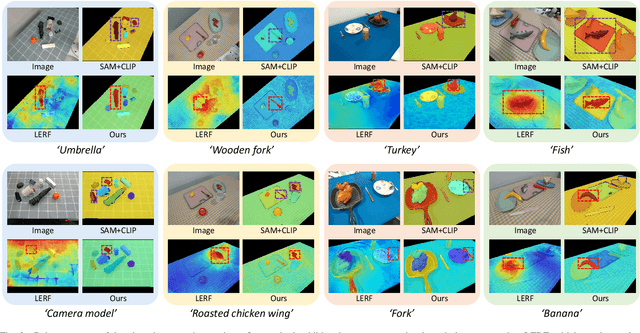
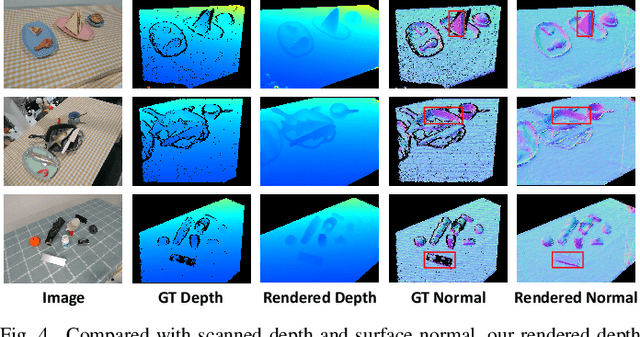
Abstract:Constructing a 3D scene capable of accommodating open-ended language queries, is a pivotal pursuit, particularly within the domain of robotics. Such technology facilitates robots in executing object manipulations based on human language directives. To tackle this challenge, some research efforts have been dedicated to the development of language-embedded implicit fields. However, implicit fields (e.g. NeRF) encounter limitations due to the necessity of processing a large number of input views for reconstruction, coupled with their inherent inefficiencies in inference. Thus, we present the GaussianGrasper, which utilizes 3D Gaussian Splatting to explicitly represent the scene as a collection of Gaussian primitives. Our approach takes a limited set of RGB-D views and employs a tile-based splatting technique to create a feature field. In particular, we propose an Efficient Feature Distillation (EFD) module that employs contrastive learning to efficiently and accurately distill language embeddings derived from foundational models. With the reconstructed geometry of the Gaussian field, our method enables the pre-trained grasping model to generate collision-free grasp pose candidates. Furthermore, we propose a normal-guided grasp module to select the best grasp pose. Through comprehensive real-world experiments, we demonstrate that GaussianGrasper enables robots to accurately query and grasp objects with language instructions, providing a new solution for language-guided manipulation tasks. Data and codes can be available at https://github.com/MrSecant/GaussianGrasper.
Efficient Prompt Tuning of Large Vision-Language Model for Fine-Grained Ship Classification
Mar 13, 2024Abstract:Fine-grained ship classification in remote sensing (RS-FGSC) poses a significant challenge due to the high similarity between classes and the limited availability of labeled data, limiting the effectiveness of traditional supervised classification methods. Recent advancements in large pre-trained Vision-Language Models (VLMs) have demonstrated impressive capabilities in few-shot or zero-shot learning, particularly in understanding image content. This study delves into harnessing the potential of VLMs to enhance classification accuracy for unseen ship categories, which holds considerable significance in scenarios with restricted data due to cost or privacy constraints. Directly fine-tuning VLMs for RS-FGSC often encounters the challenge of overfitting the seen classes, resulting in suboptimal generalization to unseen classes, which highlights the difficulty in differentiating complex backgrounds and capturing distinct ship features. To address these issues, we introduce a novel prompt tuning technique that employs a hierarchical, multi-granularity prompt design. Our approach integrates remote sensing ship priors through bias terms, learned from a small trainable network. This strategy enhances the model's generalization capabilities while improving its ability to discern intricate backgrounds and learn discriminative ship features. Furthermore, we contribute to the field by introducing a comprehensive dataset, FGSCM-52, significantly expanding existing datasets with more extensive data and detailed annotations for less common ship classes. Extensive experimental evaluations demonstrate the superiority of our proposed method over current state-of-the-art techniques. The source code will be made publicly available.
 Add to Chrome
Add to Chrome Add to Firefox
Add to Firefox Add to Edge
Add to Edge